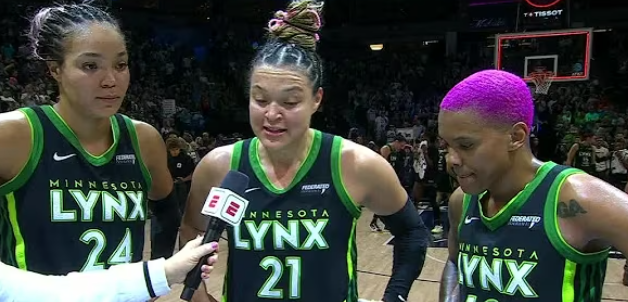During the first game of a semi-final in the WNBA, Minnesota Lynx reversed the tide on Phoenix Mercury and did it with a vengeance. The Lynx trailed at the half, but emerged stronger in the second half and smothered the Phoenix attack, and acquired a 1-0 series lead. Game 2 is now looming over the horizon: will Phoenix regain their initial fire, or will Minnesota continue winning momentum?
How Game 1 Unfolded
Phoenix jumped out fast. They scored 47 by halftime, 42 of which were in the paint, which physically imposed itself, was attacking in transition, and appeared powerful under the rim. However, all that changed after the recess. Minnesota had to adapt, Phoenix became cold through deep and the Lynx had to run the court, close passing lanes, force turnover and finally win 82-69.
Key performances:
- Courtney Williams (Lynx): 23 points, 8 boards, 7 assists, 5 steals a stat sheet performance in both the offense and defense.
- Kayla McBride: ~21 points; she led the charge in the second half together with Williams.
- Napheesa Collier: Held the boards together, she scored 18 points and 9 rebounds, which brings stability.
- In the case of Phoenix: Kahleah Copper had 22 points; Alyssa Thomas was almost a triple-dub. But they were not supported; the shooting and peripheral defense of the supporting cast failed at the right moment.
What Phoenix Needs in Game 2
The Mercury needs to change a few aspects to prevent the risk of falling into an 0-2 hole, particularly on the road:
- Perimeter shooting has to be enhanced. Game 1 they only made 3-of-23 beyond the arc. To Phoenix, distant shots are an release of interior pressure as they open up the paint. In the absence of that, they are left at risk.
- Better second-half performance. The halftime adjustments that Minnesota made whittled away the superiority of Phoenix. Phoenix will have to have countermeasures to such runs whether it is schemes, matchups, or energy.
- Stable contribution outside the stars. As much as Copper and Thomas are trustworthy, such a game of this size needs to be played by role players. When an outsider is able to make 8-12 strong points, the weight is taken off.
- Defensive poise. Minnesota will squeeze. Turnovers, poor communication, poor closeouts, and so on will not be tolerated. Phoenix has to guard the ball and challenge every shot particularly in the end.
The Minnesota Advantage: Momentum + Balanced Attack.
Minnesota is confident, going into Game 2. They did it at the right time and several players rose to the occasion. Some observations:
- The second half of Game 1 deserves special mention when it comes to their defense. Close the paint shop, shoplift, manage the glass, they did the nasty job.
- They have not been able to rely on a single star in their scoring. Collier, Williams, and McBride are heavy hitters but the concerted effort is genuine. It leaves Phoenix with fewer points of weakness.
- Home court advantage is looming huge. Lynx have been excellent at home this season (one of the most successful records in the league), and historically they were likely to be on point before their fans.
Same-Game Parlay Picks/ Strategy.
The following are some examples of parlay (moderate to long shots) that will be consistent with the things we observed in Game 1 and what we are likely to see heading into Game 2:
- Balanced, safer parlay: First half winner Lynx. Betting on Lynx to win the first half is sound considering their good home half records and the fact that the Game 1 was characterized by a Phoenix being ahead at the beginning, but later falling.
Alyssa Thomas double-double. She has passed by that threshold on numerous occasions rebounds assists or board domination are her business.
Napheesa Collier 2-2. She has solid rebounding, reliable scoring, with enough room provided by Phoenix with her focus elsewhere. - Medium risk, more reward: Add the following players to the list: Satou Sabally that scores 10 or more; Natisha Hiedeman that becomes a productive player on the bench; Collier that scores 20 or more. These props are pegged on matchups and minutes.
- Long shot special: To the people who want to shoot to have higher payout, Collier 30 points and above, Sabally making 3 or more three-pointers, Mercury first to twenty points. These are more difficult but not impossible, particularly when there is momentum and scoring spurts may occur.
Historical Context & Trends
This series (and many others) can be summarized as having a story that states that teams who are able to turn things around at the half time, tend to take that into the following matches. Deficit to deficit, tweaking, that is what it has been all about with great WNBA teams. Minnesota has demonstrated toughness in the past, as has Phoenix, but recently the victories have needed keen playing at the very beginning of the game until the final buzzer sounds.
The Mercury-Lynx rivalry has also had its share of the stylistic contrast: Phoenix has been more prone to using pace, transition, and inside-outside balance; Minnesota with physicality, defense, and the capacity to close games. Minnesota has to stretch when the perimeter shot by Phoenix makes, and suffocating with the Lynx lockdown.
My Take: Who Holds the Edge?
I would give Minnesota the edge to finish off Game 2. They possess a dynamic, they have already demonstrated that they can adapt, and their richness seems less questionable. At that, Phoenix is not new to pressure. When they manage to survive the initial quarter without going into a major rut, it is possible that their star power and creative ability in offense might trouble Minnesota.
Above all, Game 2 will involve mental toughness more than anything as to which team will want to tell the story, and which team will be able to ride the narrative.





